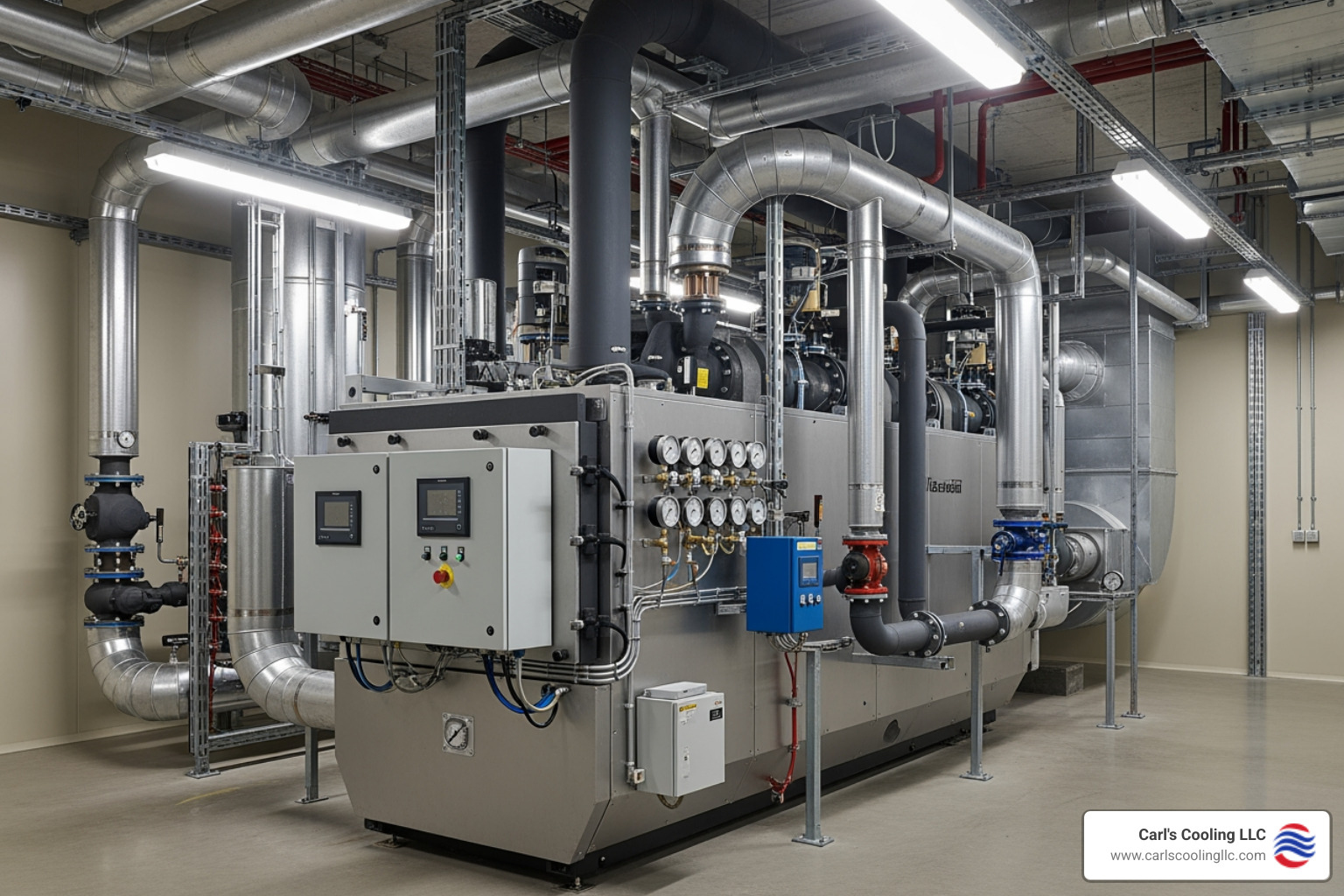Why Thermostat Wars Are a Thing of the Past
A zoned AC system divides your home into separate areas, each controlled by its own thermostat, allowing different rooms to maintain different temperatures simultaneously. Instead of one thermostat controlling your entire home, zoning uses motorized dampers in your ductwork to direct airflow only where it's needed.
Quick Answer - What You Need to Know:
- What it is: An HVAC system that creates multiple temperature zones in your home
- How it works: Uses dampers in ducts + individual thermostats per zone
- Key benefit: Each room gets its own temperature control
- Energy savings: Up to 30% reduction in heating and cooling costs
- Best for: Multi-story homes, rooms with large windows, varying occupancy patterns
Many homeowners are frustrated by hot and cold spots. The problem is simple: traditional AC systems treat your entire home like one big room. Your upstairs bedrooms might be sweltering while your basement stays chilly, leading to endless "thermostat wars" between family members.
Zoned systems solve this by giving you personalized comfort in each area of your home. Your home office can stay cool and focused while your living room maintains a cozy temperature for movie night. No more compromise - just comfort where you need it, when you need it.
The bonus? You'll stop wasting energy cooling or heating rooms that nobody's using. That translates to real savings on your utility bills and less wear on your HVAC equipment.
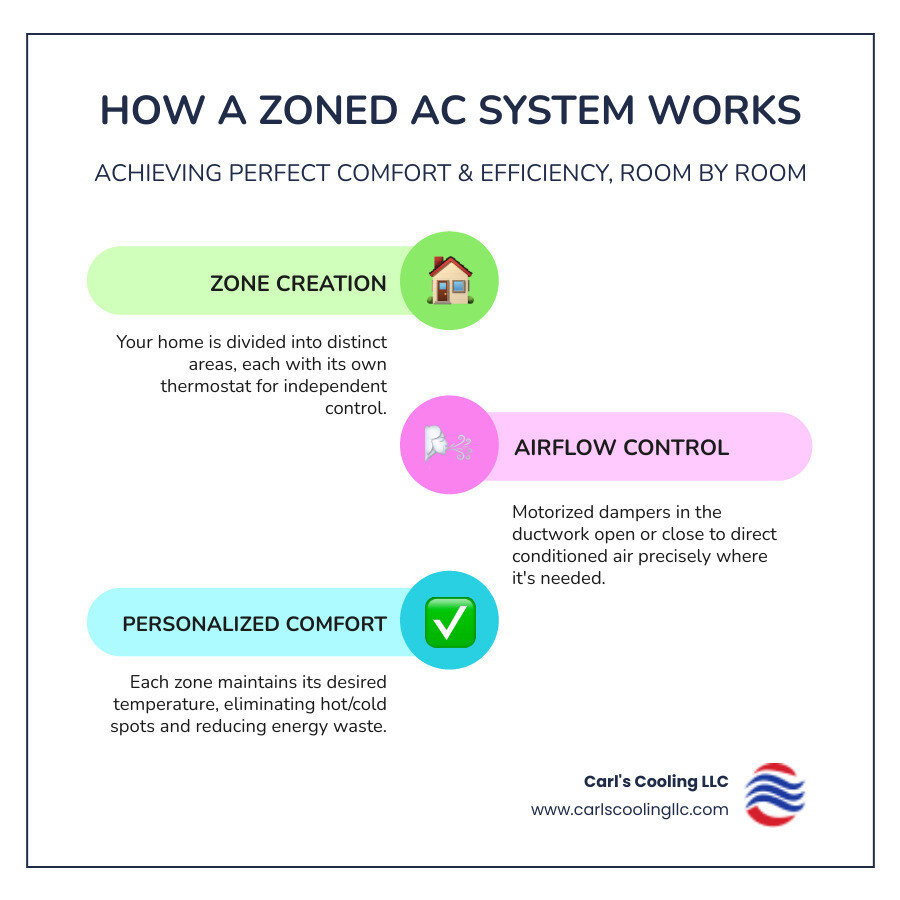
What is a Zoned AC System and How Does It Work?
Think of your home like a restaurant with different dining rooms - each space has its own mood lighting and temperature to create the perfect atmosphere. A zoned AC system works the same way, dividing your home into separate areas where each zone gets its own personalized climate control.
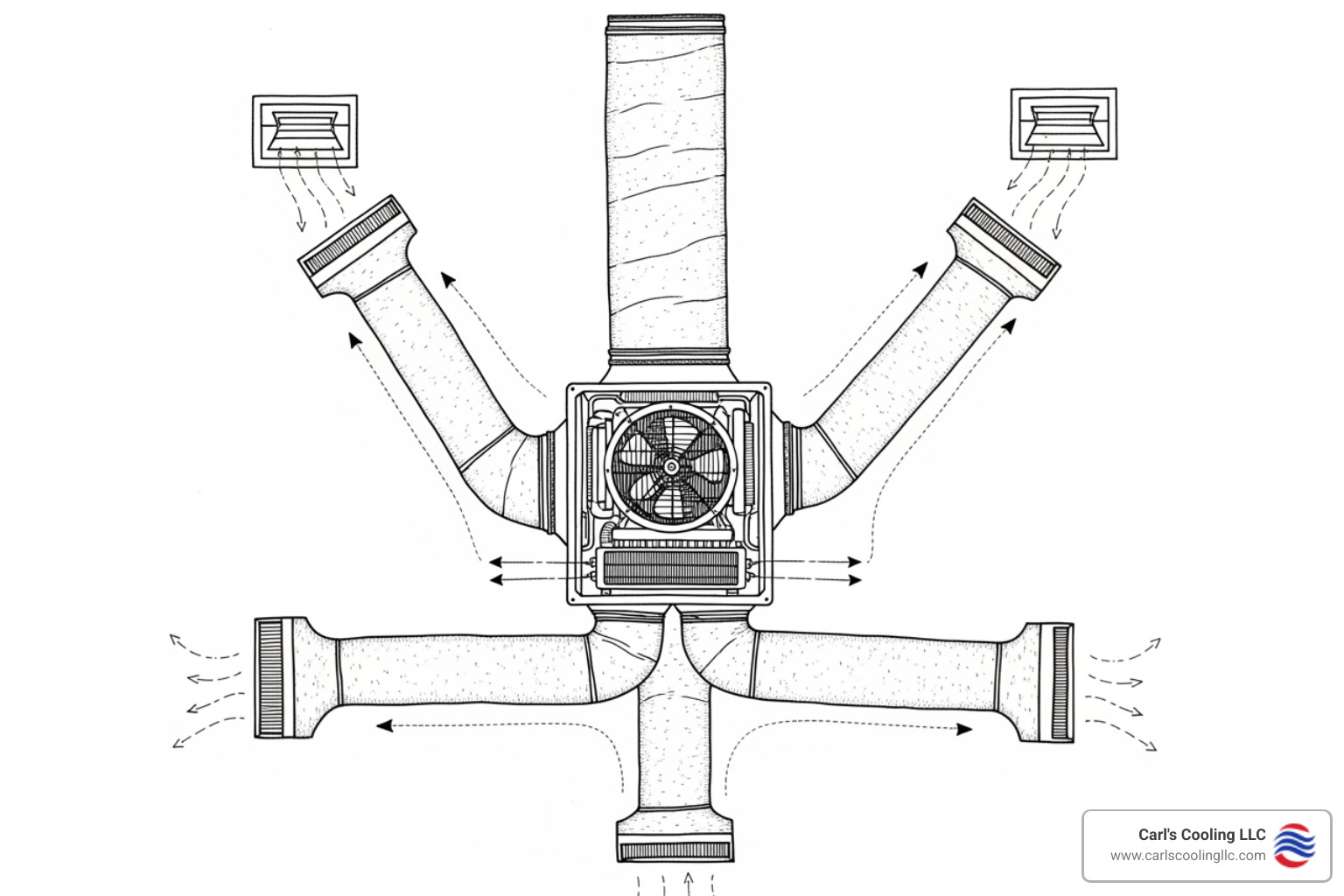
Here's what makes it different from your regular AC system: instead of treating your entire house like one big room, a zoned AC system creates multiple climate-controlled areas. Your kitchen can stay cool while you're cooking dinner, while your cozy bedroom maintains the perfect temperature for sleeping - all at the same time.
The magic happens through smart airflow control. The system only sends heated or cooled air to the zones that actually need it. No more wasting energy on empty rooms or fighting over the thermostat settings.
The Role of Dampers and Thermostats
Every zoned AC system relies on two key players: motorized dampers and individual thermostats.
Motorized dampers are automated valves installed in your ductwork that open and close to control how much conditioned air flows to each zone. When your home office needs cooling, its damper opens. When nobody's in the guest bedroom, that damper can stay closed, saving energy.
Zone thermostats are the brains of each area. Every zone gets its own thermostat that constantly monitors the temperature and communicates with the central control system. Many homeowners upgrade to smart thermostats for their zones to adjust temperatures from their phone, set schedules, and let the system learn their routines.
This setup means your teenager can keep their room nice and cool while your parents prefer their guest room a bit warmer. Everyone stays comfortable without compromise.
The Basic Workflow: From Thermostat to Comfort
The process is simple and automatic. When a zone's thermostat detects the temperature is off, it signals the central control panel. The panel then instructs the motorized damper for that specific zone to open and tells your main HVAC unit to start producing conditioned air. This air is directed only to the zone that needs it. Once the target temperature is reached, the thermostat signals the panel, which then adjusts the damper and cycles down the system if no other zones are calling for air. This efficient process ensures targeted comfort without wasting energy on rooms that are already comfortable.
Key Benefits of HVAC Zoning
When you invest in a zoned AC system, you're not just buying another piece of equipment – you're changing how your home feels and functions. Think of it as upgrading from a basic car to one with all the features that make driving a pleasure rather than a chore.
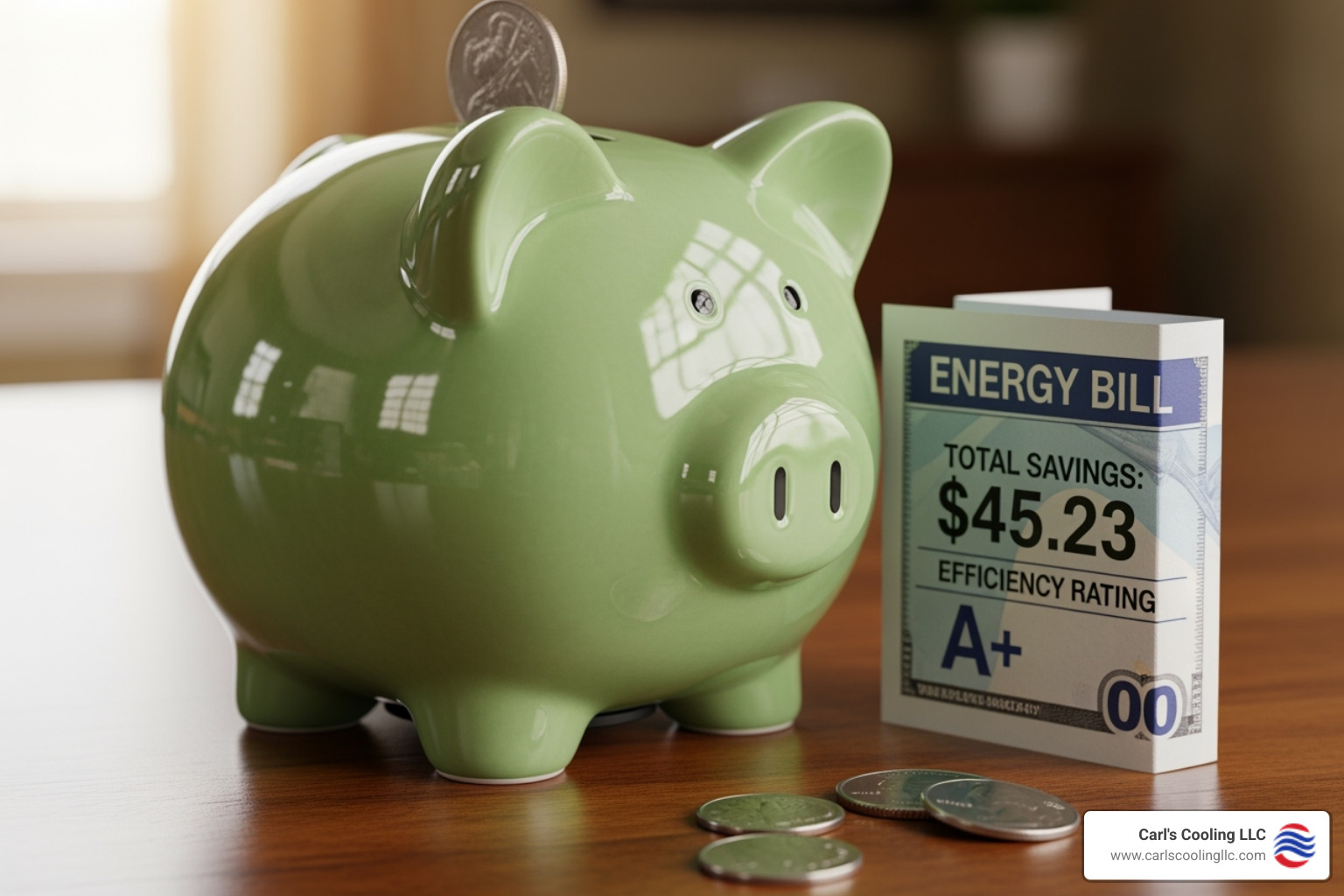
The benefits go way beyond just stopping those frustrating arguments about the thermostat. We're talking about real energy savings that show up on your monthly bills, equipment that lasts longer because it's not overworked, and comfort that's custom to how you actually live in your home.
Here's something that might surprise you: according to the U.S. Department of Energy, proper HVAC zoning can slash your heating and cooling costs by up to 30%. That's like getting a month of free climate control every few months! Energy savings of up to 30%
How a Zoned AC System Improves Home Comfort
A zoned AC system makes peace possible when family members have different temperature preferences.
Eliminating hot and cold spots is the most immediate benefit. Traditional systems struggle with problem areas like upstairs bedrooms that get too hot or basements that stay chilly. With zoning, each area gets what it needs. A sun-drenched room can stay cool without freezing a shaded room. This is especially beneficial for multi-story homes where heat naturally rises.
Accommodating different preferences becomes effortless. Your home office can stay cool for productivity while bedrooms are set to ideal sleeping temperatures, all without affecting the rest of the house. This leads to consistent temperatures within each zone, creating a more stable and comfortable environment. You may also notice quieter operation, as the system doesn't have to work as hard and can run more gently.
Achieving Significant Energy Savings
Here's where a zoned AC system really pays for itself – literally. The energy savings are substantial and show up month after month on your utility bills.
Cooling occupied rooms only is the game-changer. Why waste energy conditioning your guest bedroom when no one's using it? Or heating the basement during the day when everyone's upstairs? With zoning, you simply dial back unoccupied areas to minimal settings or turn off conditioning entirely in unused zones.
Picture this: you're working from home, so you keep your office perfectly comfortable while setting the bedrooms to save energy until evening. Or maybe you're hosting a dinner party, so you focus the cooling on your main living areas while letting the upstairs coast.
Reduced energy waste happens naturally when your system delivers conditioned air only where it's needed. Instead of your HVAC unit working overtime to cool or heat every square foot of your home, it targets just the zones that are calling for comfort. This targeted approach means your equipment isn't fighting a losing battle against unused spaces.
Lower utility bills are the direct result. That 30% savings from the Department of Energy translates to real money back in your pocket. Over time, these savings help offset your initial investment while continuing to benefit your budget year after year.
Programmable schedules take the savings even further. Modern zone thermostats, especially smart ones, learn your routine and adjust automatically. Your bedroom can start cooling down before bedtime, your bathroom can warm up before your morning shower, and your home office can be perfect when you start your workday – all without you lifting a finger.
Less strain on your AC unit means your equipment lasts longer and needs fewer repairs. When your system only has to condition specific zones instead of battling to cool or heat your entire home, it experiences less wear and tear. It's like the difference between sprinting a marathon versus pacing yourself – your equipment will thank you with years of reliable service.
The efficiency benefits mirror what we see with The Benefits of Efficient Mini Split HVAC Systems, where targeted comfort leads to impressive energy savings.
Is Zoning the Right Choice for Your Home?
Not every home needs a zoned AC system, but when the right conditions exist, it can be a game-changer for comfort and energy bills. Think of it this way: if your home has personality quirks that make some rooms feel like different climates, zoning might be exactly what you need.
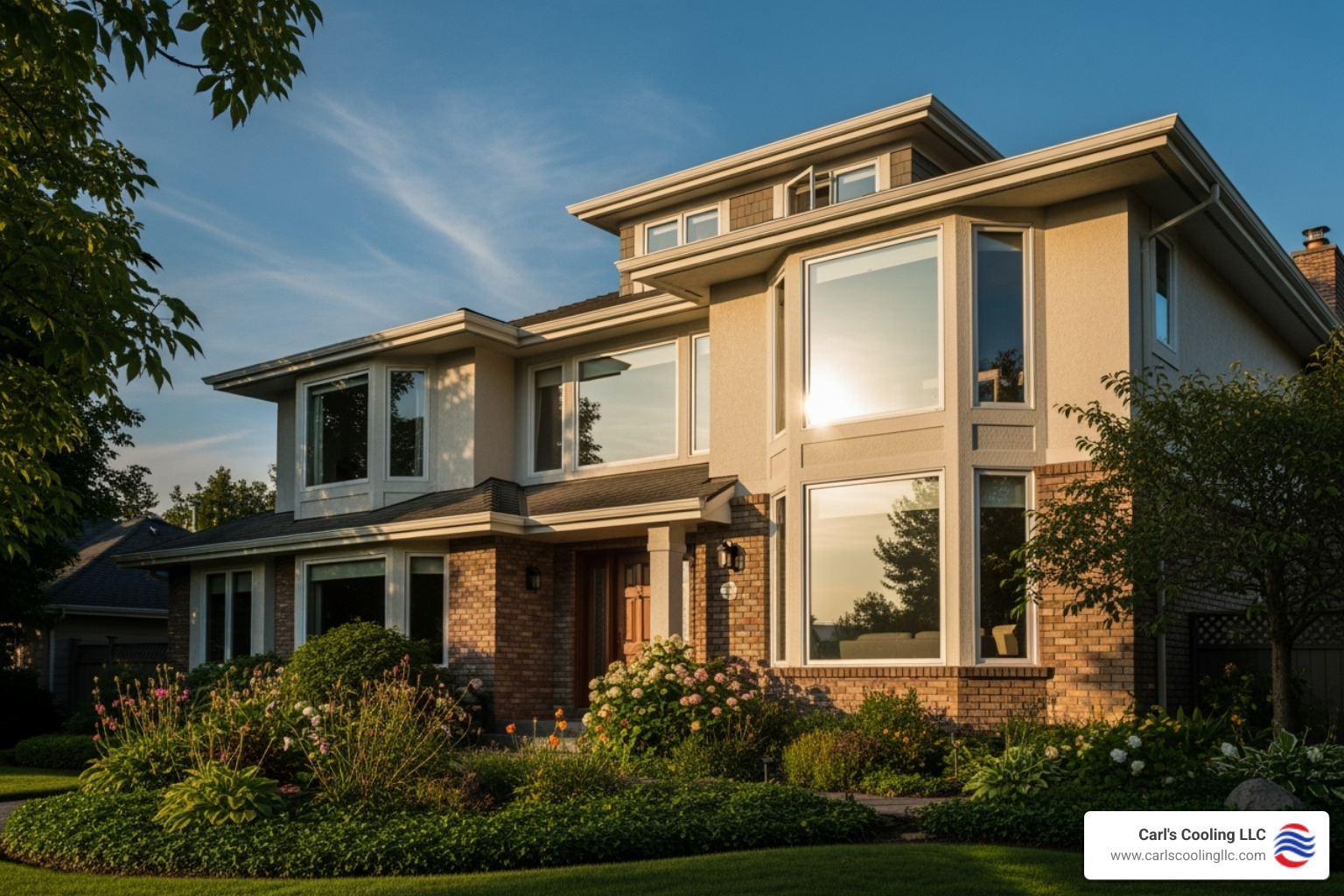
The key is understanding your home's layout, how your family actually uses different spaces, and whether you're dealing with those frustrating temperature inconsistencies that make you wonder if your thermostat is playing tricks on you.
Some homes practically beg for zoning. Others work just fine with traditional systems. The difference often comes down to architectural features, sun exposure, and how different areas of your home behave throughout the day.
Homes That Benefit Most from Zoning
Multi-story homes are the classic candidates for zoning. Physics isn't negotiable - heat rises, which means your upstairs bedrooms can feel like a tropical vacation while your basement stays cool as a cave. A zoned AC system lets each floor maintain its own comfortable temperature without the constant thermostat battles.
Sprawling ranch-style homes face similar challenges, just spread horizontally instead of vertically. When your master bedroom is at one end of the house and your living room is at the other, that single thermostat in the hallway isn't doing justice to either space.
Finished basements or attics create their own climate challenges. These spaces often feel completely different from the main living areas because of their location and how they're constructed. Zoning gives these unique spaces the individual attention they need.
Homes with large glass windows or sunrooms can turn into greenhouses on sunny days, requiring much more cooling than the rest of the house. Instead of freezing out your kitchen to cool down that sun-drenched living room, zoning handles each area appropriately.
Home offices or gyms have specialized needs too. Your home office might need to stay crisp and cool for productivity, while other rooms can be more relaxed. A home gym definitely needs extra cooling power during workout sessions, but you don't want the whole house feeling like an icebox.
Historic homes often present unique challenges with their original layouts and construction. While retrofitting these beautiful homes with modern ductwork can be complex, solutions like ductless systems offer inherent zoning capabilities. We've found that Mini Splits for Older Home Cooling Solutions work particularly well in these situations.
Homes with varying occupancy patterns also benefit significantly from zoning. If you have guest bedrooms that sit empty most of the year, or a formal dining room that only gets used for holidays, why waste energy keeping those spaces perfectly conditioned all the time?
Potential Drawbacks to Consider
Let's be honest about the challenges. A zoned AC system isn't a simple swap-out project. The installation complexity can be significant, especially if you're retrofitting an existing home. We're talking about installing motorized dampers in your ductwork, running new wiring for multiple thermostats, and integrating everything with a central control panel. It's definitely more involved than a standard HVAC installation.
The upfront investment is also higher than traditional systems. You're paying for additional components like dampers, multiple thermostats, and the control panel, plus the specialized labor to install everything properly. However, many homeowners find that the energy savings over time help offset this initial investment.
This definitely requires professional installation. We can't stress this enough - proper design and installation are absolutely critical for a zoned AC system to work effectively. Get it wrong, and you could end up with air pressure issues that actually damage your HVAC equipment, or zones that never quite reach the right temperature.
When installed correctly by experienced professionals, though, these systems can transform how your home feels and significantly reduce your energy bills. The key is working with someone who understands the intricacies of zoning design and can ensure everything works together seamlessly.
Zoned Systems vs. Other Cooling Solutions
When you're ready to upgrade your home's comfort, you've got three main paths to consider. Each has its place, but understanding the differences will help you make the best choice for your specific situation and budget.
| Feature | Zoned Ducted Systems | Traditional Central Air | Ductless Mini-Splits |
|---|---|---|---|
| Zone Control | Excellent (multiple independent zones) | Limited (single zone, whole house) | Excellent (individual room/area control) |
| Energy Efficiency | High (conditions only occupied zones, reduces waste) | Moderate (conditions entire house, can waste energy) | Very High (no duct loss, precise room control) |
| Installation | More complex (dampers, wiring, control panel) | Standard (ductwork required) | Less invasive (no ducts, small refrigerant lines) |
| Best Use Case | Multi-story homes, large homes with varying needs | Homes with consistent temperature needs | Older homes, additions, individual room comfort |
| Aesthetics | Ducted (vents visible) | Ducted (vents visible) | Wall-mounted indoor units visible |
Traditional central air is the familiar workhorse that most of us grew up with. Picture one outdoor unit connected to an indoor air handler, pushing conditioned air through ducts to every room in your house. It's reliable, but it treats your entire home like one big room.
Here's the catch: that single thermostat (usually tucked away in a hallway) controls everything. When your upstairs bedrooms are sweltering at 78°F, the system keeps pumping cold air until that hallway thermostat reads 72°F. Meanwhile, your basement might be a chilly 68°F, and you're burning energy cooling rooms nobody's using.
It's like having one light switch for your entire house - functional, but not very smart.
A zoned AC system takes that same ducted approach but adds intelligence. Instead of one thermostat calling all the shots, you get multiple zones with their own thermostats, each directing airflow through motorized dampers. Your upstairs can stay cool while your basement maintains a comfortable temperature, and empty rooms can be left alone.
How Does a Zoned AC System Compare to Ductless Mini-Splits?
Both zoned AC systems and ductless mini-splits give you that coveted individual room control, but they get there through completely different approaches.
The fundamental difference lies in how they deliver comfort. A ducted zoned AC system works with your existing ductwork (or new ducts if needed), using those motorized dampers we talked about to control where the air goes. Mini-splits skip the ducts entirely - they connect individual indoor units directly to an outdoor unit through small refrigerant lines.
Think of mini-splits as giving each room its own personal air conditioner. Each individual air handler mounted on your wall or ceiling has its own remote control and thermostat. You want your bedroom at 68°F while keeping the living room at 74°F? No problem. Each unit operates independently, giving you true per-room control.
Installation tells a different story for each system. For a ducted zoned system, we're working within your existing ductwork infrastructure, adding dampers, running thermostat wires, and installing the central control panel. With mini-splits, we only need to drill a small hole through your wall to connect the indoor and outdoor units with refrigerant lines - much less invasive, especially if your home doesn't have existing ductwork.
Aesthetically, ducted systems keep that clean look with traditional vents flush against your walls or ceilings. Mini-split indoor units are visible - usually sleek, wall-mounted units that some homeowners love for their modern appearance, while others prefer the hidden nature of ducted systems.
The sweet spot for each system really depends on your home's situation. A zoned AC system shines in larger homes with good existing ductwork where you want to create logical zones - maybe upstairs versus downstairs, or separating the master suite from kids' bedrooms. Mini-splits excel in older homes where adding ductwork would be a nightmare, room additions, or situations where you need surgical precision in conditioning specific spaces.
If you're dealing with an older home that's fighting you on traditional ductwork, mini-splits might be your best friend. Check out our Ductless AC Systems to see if this approach fits your needs.
The bottom line? Both systems solve the same core problem - giving you control over your comfort without wasting energy. The choice often comes down to your home's existing infrastructure and how you prefer to achieve that control.
Frequently Asked Questions about Zoned HVAC
We get it - investing in a zoned AC system is a big decision, and you probably have questions. After years of helping homeowners make this choice, we've heard just about every concern and curiosity. Let's tackle the most common ones head-on.
How does zoning impact indoor air quality?
Here's some great news: a zoned AC system can actually improve your home's air quality in ways you might not expect.
Think about it this way - in a traditional system, air constantly circulates throughout your entire house. If your basement workshop is dusty or your pet's favorite room gets a bit stuffy, that air gets mixed with everything else and spread around. With zoning, we can isolate airflow to specific areas, which means contaminants stay put instead of taking a tour of your whole home.
But it goes deeper than that. Better filtration becomes possible when you're managing airflow more precisely. Your filtration system can work more effectively within each zone, catching more of those airborne particles that make you sneeze.
And here's something many people don't consider: humidity control. Nobody wants that clammy feeling or, worse, mold growing in dark corners. A zoned AC system, especially when paired with smart thermostats, helps manage moisture levels more effectively in different areas. Your bathroom can stay properly ventilated while your living room maintains that perfect, comfortable humidity level.
What are the maintenance requirements for a zoned HVAC system?
The good news? Maintaining a zoned AC system isn't rocket science. It's similar to caring for a traditional system, just with a few extra checkboxes.
Regular HVAC tune-ups are still your foundation - we're talking about annual professional visits to check your main furnace and air conditioner. We'll look at refrigerant levels, clean those coils, and make sure everything's humming along nicely.
The zoning-specific maintenance focuses on those motorized dampers - the hardworking components that make the magic happen. During maintenance visits, we inspect these to ensure they're opening and closing properly and aren't blocked by dust bunnies or wayward toys.
Thermostat calibration is another key piece. With multiple thermostats throughout your home, we want to make sure they're all reading temperatures accurately and talking to the control panel without any communication hiccups.
Don't forget about ductwork integrity checks. Since your zoned AC system relies on efficient airflow, we'll inspect for leaks or blockages that could throw off performance. And yes, filter changes are still essential - clean filters every 1-3 months keep everything running smoothly and prevent dust from taking up residence in your ducts.
Can I add zoning to my existing HVAC system?
Absolutely! This process, called retrofitting, is more common than you might think. However, success depends on a few key factors that we'll need to evaluate.
Ductwork assessment is where we start. For a zoned AC system to work effectively, your existing ducts need to be in good shape and designed in a way that allows us to create separate zones. Some older homes have ductwork that's undersized or configured in a way that makes zoning challenging without significant modifications.
System compatibility is another consideration. Most modern HVAC units play nicely with zoning controls, but older systems might need some upgrades to work effectively with the new setup.
Here's where professional evaluation becomes crucial. Every home is unique - your layout, existing HVAC equipment, and ductwork all factor into the equation. Our experienced technicians can walk through your home, assess what you have, and recommend the best approach. We'll help you understand the optimal number of zones for your space and what type of dampers will work best.
While retrofitting requires an investment, the improved comfort and energy savings often make it worthwhile. Plus, you'll finally win those thermostat wars once and for all!
Achieve Perfect Comfort in Every Room
Imagine walking through your home and feeling perfectly comfortable in every single room. No more cranking up the AC because the upstairs is sweltering, only to freeze out everyone downstairs. No more family debates over the thermostat setting. With a zoned AC system, this dream becomes your daily reality.
Customized home comfort isn't just a luxury - it's a practical solution to one of the most common household frustrations. When your teenager can keep their room cool for studying while grandma enjoys a warmer temperature in her favorite reading chair, everyone wins. That's the beauty of zoning: it adapts to your family's unique needs instead of forcing everyone to compromise.
Beyond the immediate comfort benefits, you're making a smart investment in your home's future. The precision control of a zoned AC system means you're not throwing money out the window by cooling empty rooms or fighting against your home's natural temperature variations. Those long-term savings on utility bills add up significantly over the years, making the system practically pay for itself.
Your HVAC equipment will thank you too. When your system doesn't have to work overtime trying to force one temperature throughout your entire home, it experiences less stress and strain. This translates to fewer repair calls, longer equipment life, and more reliable performance when you need it most.
Problem-solving is what we do best at Carl's Cooling LLC. We understand that every home has its own personality - from that sun-drenched living room that turns into a greenhouse by afternoon, to the basement that stays chilly year-round. Our team specializes in creating zoned solutions that work with your home's unique characteristics, not against them.
Whether you're dealing with a multi-story home where heat rises relentlessly, or you have specific rooms that see heavy use while others sit empty, we'll design a zoned AC system that makes sense for your lifestyle. We take the time to understand how you live in your space, ensuring every zone serves a real purpose.
Ready to transform your home into a haven of personalized comfort? We're here to guide you through every step of the process, from initial consultation to final installation and beyond. And if you're curious about other flexible cooling options, don't forget to explore ductless AC options for your home in The Woodlands, TX - another excellent way to achieve room-by-room comfort control.
Your perfect home climate is just a conversation away.





